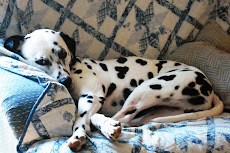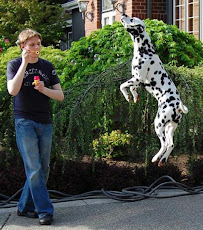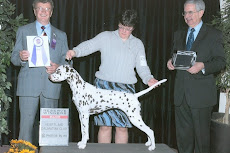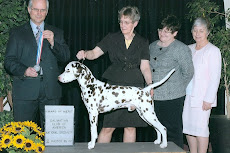When I posted to Facebook about a judging panel I did not care for, I got an email asking me the difference between a good judge and a bad judge. I've been thinking about that for awhile and it occurred to me that putting my thoughts on paper might be interesting. Sometimes I surprise myself when I get caught up in writing.
Some judges are just good all around judges. Knowledgeable, fair, efficient, nice to both dogs and people. Their opinions are respected by most exhibitors, and a win under one of them is memorable. Because dogs are judged to a written standard, and because they are judged based on the judge's interpretation of that standard, the results will vary. I can like & respect Judge Aye, but know that he is not a suitable judge for a dog I am currently showing. His mental image for the ideal Dal may be somewhat different than mine and if I show to him I do it knowing that my dog might not be quite what he is looking for. That does not make him a bad judge, just not an ideal judge for my dog, bur depending on the competition, my dog may win because there is nothing in the ring that he likes better.
Because our dogs are not all alike, and we show what we have, some judges may be good for some of our dogs and not good for others. When I was showing my first Best In Show winner "Morris", I did not show him to a particular judge I knew would not care for him. Morris just wasn't the type of Dal he used. This same judge gave my current Best Im Show dog "Argus" the Dalmatian National a couple of years ago. Argus is a different style of dog than Morris, and the type this particular judge prefers. Both were good dogs, but somewhat different in size, type, outline and gait.
If judges were consistent in what they put up, we could save ourselves a lot of entry fees, but unless there is a good sized entry of quality dogs, the judge has to judge what they have to work with and may not have a dog of the type/style they prefer. Some judges we KNOW will not use high tails, big dogs, heavy markings, whatever, but sometimes they don't have a choice and the best dogs may have features the judge dislikes - but has to use on that day. Some judges have things they will not use, no matter how good the overall dog and no matter how bad the competition. That's unfortunate, because they are supposed to be judging the whole dog, the sum of its parts. Unless that feature affects soundness such as very bad feet or extreme cow hocks, or is a temperament flaw such as shyness or aggression, it's just a fault and all dogs have them.
Most judges do their best on any given day, but there are a few dumb ones. The dumb ones are usually poor judges in all breeds, but sometimes they are just bad with specific breeds - as if they hadn't a clue as to what the standard calls for and what the breed should look like. This is often based on not liking a breed. Although we should be judging all breeds fairly, there is some bias of course, and some judges just don't like Dalmatians, the same way you and I just don't care for certain breeds. It's unfortunate that this happens, but if you want to judge the Non Sporting Group, you judge all the breeds in it - including Dalmatians. We try to avoid the judges we know don't care for the breed, but will sometimes show to the dumb ones and take our chances, as long as they are pleasant to dogs and exhibitors.
There are also judges who are inexperienced in a breed but will do a better job as they gait confidence. They are often confused about spotting, patches, tri-colors and breed specific things they don't understand. They often waste time looking for patches, odd colored spots, or trying to decide if the spotting is OK. They are often "spot counters" for awhile, judges who put too much emphasis on markings as they try to do the safe thing. Spotting is 25% of the breed standard, but structure and temperaments are 75%!
There are a lot of judges who are what I call Doggy Socialites - they judge for the ego trip, but are not good dog people and really don't understand or can not recognize a quality dog of any breed. A judge has to have an eye for balance, proportion and quality, and has to understand and be able to form a mental picture from written words. Some will never be able to do that, no matter how well intentioned they may be.
Too be continued . . .
Subscribe to:
Post Comments (Atom)
















































2 comments:
Just a question about the biking. Is Argus just very well behaved and you can ride a bike and hold a leash at the same time? Also, I took my most recent rescued Dal in for a blood panel, which turned out to be normal,but the vet on duty since my vet was out was very upset with me when she saw on my record that I used the Barf diet....she told me to stop immediately because my dog would get toxoplasmosis (sp)?? She went on and on about bacteria, salmonella, etc............do you ever get this?? Thanks, really enjoy your blog.
Jen from Chattanooga
Hi Sue,
Question for you: Read in your blog about flaws in dogs that are severe, such as extreme cow hocks. This is probably a very silly question but what constitutes extreme? How do you know if it is minor or a big problem? My pup is almost five months old and has just hit a major growth spurt and it was in the midst of said spurt that I began to notice that when he stands a certain way, his hocks go in and his toes point out. Sometimes just a hair, sometimes it's very noticeable. Two weeks ago we met up with two of his siblings and I took the time to compare and they both looked to have perfect back legs...they were also considerably shorter than him. I spoke to my vet who said it could be due to the growth spurt and that he will likely grow out if it. In your experience, what do you think? Is it something they can grow out of or something that improves with age or will he always stand that way? Thanks so much.
Post a Comment